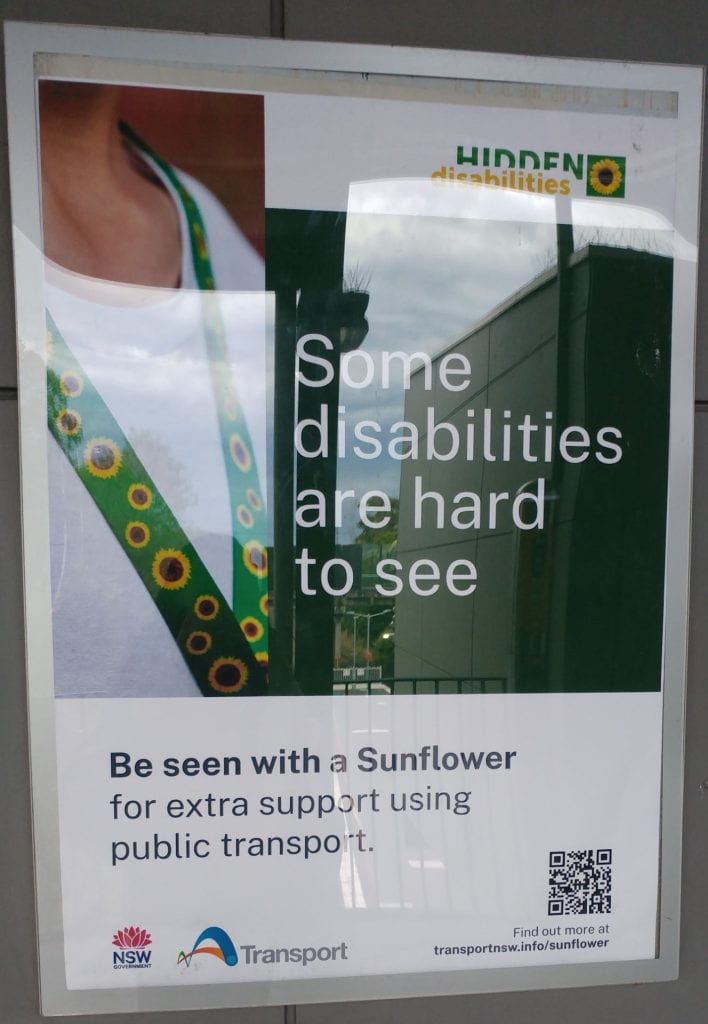Globally 1 in 7 people have a disability. 80% of those are hidden/ invisible (Hidden Disabilities Sunflower, 2022).
Hidden disabilities are illness, conditions, impairments etc. that are not immediately apparent or obvious that significantly impair normal activities of daily living. This includes autoimmune disorders, chronic illness, neurological, and visual and auditory disabilities.
Many people choose to stay silent, not disclosing their disabilities. This is due to hidden disabilities are difficult to recognise, understand and acknowledge. Hidden disabilities also may not present physically, leading to people with disabilities to be unfairly judged.
The first article is Erika England’s story. Erika suffers from Chronic pain which fluctuates every day, from being able to do physically demanding tasks (e.g. clean the house by herself) one day to needing help doing basic tasks (e.g. dressing herself) the next day. Erika’s condition is not isolated to pain either, as the pain can cause sensory and cognitive problems. As all her conditions are hidden, she, like many others are negatively judged due to their age and ‘healthy’ physical appearance and get labelled as ‘lazy’ or ‘faking’. Erika describes it as “being stuck between able and disabled” (England, 2020).
Her story and many more can be found on ABC News – ABC partnered with International Day of People with Disability to celebrate the 4.4 million Australians with disability.
We need to become more accommodating to the needs of people with a disability. In the workplace, we talk about inclusivity and diversity, however these talks tend to focus on gender, religion, and caring roles, and tend to exclude disabilities. According to the second article, Abney et al. (2022), many people cannot name a co-worker who is disabled. In our discussion, some members had actually shared their disability, something that was a surprise to some.
When disabilities are talked in the workplace, it tends to be narrow, focusing on the extreme end, or in the study centre focused on course design course design, accessibility of information, and specific paces. We forget the smaller or simpler accommodations that can be made available for individuals or the wider workforce. These include:
- Specialised/ alternative workspaces/ desks
- Adjustable working hours/ alternative schedules – These are already available for people in caring roles, so expanding it to include people who have anxiety attacks etc
- Ergonomic keyboards and mice – These are helpful for people with arm and wrist disabilities. It can also prevent typing related injuries for other employees
- Providing padding on the floor – To help alleviate back stress
- Filters for computers, etc. – to help sufferers of migraines
- Earplugs – to help those who are noise sensitive
- Installing voice, text-to-speech and/ or speech-to-text software
- Making meeting recordings available
- Include closed captions/ transcripts
(Abney et al., 2022)
By making these accommodations available we could create a positive and accepting environment for everyone including people with disability, hidden or not.
Programs/ campaigns
 There are many programs/ campaigns that are raising awareness and advocating for people with disabilities/ hidden disabilities.
There are many programs/ campaigns that are raising awareness and advocating for people with disabilities/ hidden disabilities.
The “Hidden Disabilities Sunflower”, for example, uses the sunflower to raise awareness for those with hidden disabilities by discretely identifying themselves to people including staff, colleagues, and health professionals as someone who may need support, assistance or a little more time without having to disclose their invisible disability. This organisation operates in UK, USA, Canada, Australia, New Zealand, Netherlands, Belgium, Denmark, and Ireland and is recognised in over 50 countries world-wide. Many organisations have become part of the hidden disabilities network including airports, museums, shopping centres, councils, and as of 1 December, Sydney Trains.
References:
Abney, A., Denison, V., Tanguay, C., & Ganz, M. (2022). Understanding the unseen: Invisible disabilities in the workplace. The American Archivist, 85(1), 88-103. https://doi.org/10.17723/2327-9702-85.1.88
England, E. (2020). ‘Am I disabled today?’ How Erika finds strength and compassion by embracing her disabilities. ABC News. https://www.abc.net.au/news/2020-11-26/what-it-means-to-have-fluctuating-disability/12871698
Hidden Disabilities Sunflower. (2022). Invisible disabilities. https://hiddendisabilitiesshop.com.au/au/insights/category/invisible-disabilities
Resources: